Exploring Wing Surf Foil Boards: Insights and Tips
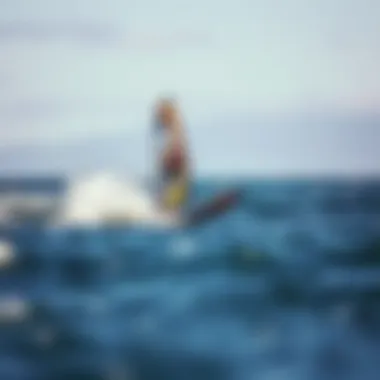
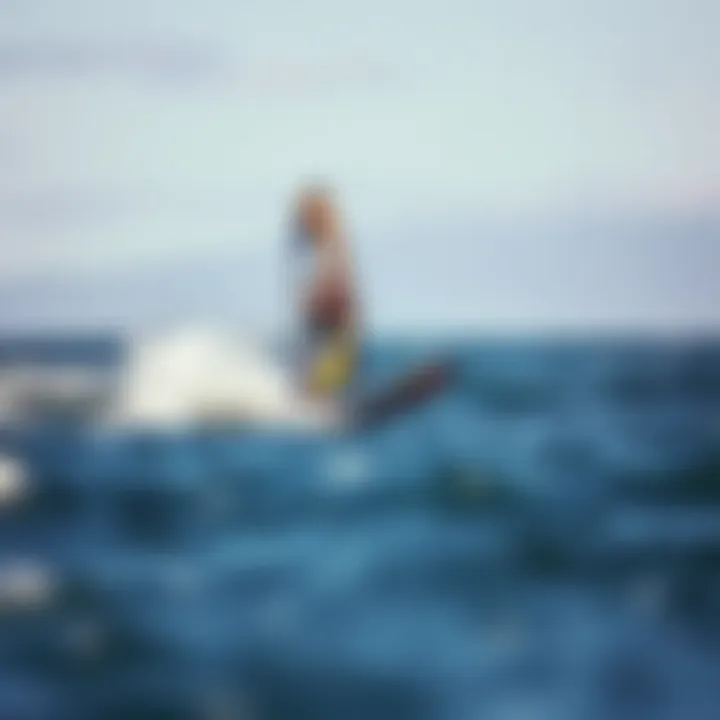
Gear and Equipment
When it comes to wing surf foiling, having the right gear is as crucial as knowing how to ride. An informed choice can make the difference between a seamless gliding experience and a frustrating session on the water. Here, we’ll outline the essentials you’ll need, spanning from starter equipment to advanced options for more seasoned riders.
Essential Equipment for Beginners
Starting out, you’ll want to gather some key items that will help you get a solid footing—literally and figuratively.
- Wing: The wing is the heart of your setup. Look for something lightweight and easy to control, especially in lighter winds. Brands like Naish and Ozone provide sturdy options for first-timers that can also accommodate varying wind conditions.
- Foil Board: Choose a board that is wide and stable. A shorter board might look sleek, but a longer width will make balancing a lot easier as you learn. Look for something in the range of 5 to 8 feet, depending on your weight and experience level.
- Foil: A simple, large foil with a high lift will make your first rides a lot smoother. If you're just starting out, consider foils with a larger front wing, which offers more lift at lower speeds.
- Safety Gear: Don’t skip on the safety. A well-fitted life jacket and a helmet can save you in unexpected tumbles. They let you focus on the fun instead of worrying about the what-ifs.
Advanced Equipment for Experienced Riders
As you ascend to the ranks of proficient riders, your gear will need an upgrade too. Improved performance, responsiveness, and speed become central to your setup.
- High-Performance Wing: At this stage, look beyond basic models. Advanced wings incorporate materials like Kevlar or UHMWPE for durability and weight reduction, enhancing your overall riding experience.
- Specialized Foil Board: Consider boards designed with enhanced hydrodynamics. Many riders favor a performance board with a tapered tail for greater maneuverability and speed.
- Custom Foils: Custom foils can be tailor-made to match your specific riding style and preferences. Whether you prefer speed, tight turns, or stability, you can find—or create—a foil that works for you.
"Getting the right gear is the first step in mastering wing surf foiling. It's not just about the ride; it's about feeling comfortable and confident on the water."
That sums up the essential and advanced wing surf gear necessary for both beginners and more experienced riders. Next, let’s dive into skills and techniques, making sure your time spent on the water is both fun and productive.
Foreword to Wing Surf Foil Boards
Wing surf foiling has taken the watersport world by storm, merging the thrilling elements of surfing, kiteboarding, and windsurfing into one exciting activity. Understanding the intricacies of wing surf foil boards is crucial for anyone looking to ride the waves with finesse and dynamism. This guide aims to shed light on the essential aspects of these boards, from their design to their growing popularity.
In essence, wing surf foil boards offer a unique riding experience; they allow riders to glide above the water's surface, tapping into the wind's energy, thus creating a sensation akin to flying. This lofty experience elevates the sport beyond traditional surfing, making it more adaptable to various water and wind conditions. With the right gear, both novices and seasoned athletes can harness the power of the wind and embark on exhilarating adventures.
Definition and Concept
At its core, a wing surf foil board is a specialized board equipped with a hydrofoil—an appendage attached beneath the board that lifts it above the water. When properly executed, this design minimizes water resistance, enabling the rider to achieve higher speeds with less effort. Foiling involves the same principles as aircraft wings, where the shape of the foil creates lift due to differences in water pressure. This technology allows for a relatively smooth ride over choppy waters, which can be a game-changer for conditions that would typically be difficult for conventional surfing.
The Rise of Wing Surf Foiling
The rise of wing surf foiling can be attributed to several factors influencing water sports enthusiasts today. Firstly, the advent of versatile designs and lightweight materials have made wing surf foil boards more accessible. Innovators in the industry continuously refine and adapt the equipment, leading to lighter and stronger boards that perform exceedingly well in diverse conditions. Additionally, social media has played a pivotal role in how this sport gathers momentum, with vibrant communities sharing tips, tricks, and experiences online. Platforms like Reddit and Facebook have various groups dedicated to wing foiling, where participants can seek advice and we share the latest trends in gear and technique.
Furthermore, as outdoor activities gain popularity, more people are drawn to unique forms of watersports that offer an element of novelty and excitement. The combination of rising interest in eco-friendly activities—preferably those that emphasize participation in nature—coupled with the thrill of mastering a new skill, positions wing surf foiling as a compelling choice for many.
"Understanding the nuances of wing surf foil boards will significantly enhance your riding experience, whether you are a beginner or a seasoned pro."
In summary, the introduction of wing surf foil boards into the watersport landscape has opened up a new world for adventurers, providing them with a dynamic and exciting way to engage with the ocean. As we progress through this guide, we'll unpack the design, advantages, and techniques associated with this exhilarating sport, providing you with all the tools needed to take to the water confidently.
Understanding the Design
Understanding the design of wing surf foil boards is crucial for grasping how they function and perform in water. This section delves into the distinct features that set these boards apart, revealing why board shape, size, foil dynamics, and construction materials play significant roles in enhancing the overall riding experience.
Board Shape and Size
The board's shape and size directly influence maneuverability, speed, and stability. When it comes to wing surf foiling, different shapes cater to various riding styles and preferences. For example, wider boards tend to provide better stability, making them an excellent choice for beginners. Conversely, long and narrow boards are typically favored by advanced riders, allowing for faster speeds and sharper turns.
It’s also essential to consider the size of the board in relation to the rider's weight. A heavier individual may find greater success with a larger board that offers more flotation, while lighter riders can opt for smaller models that increase responsiveness.
In summary, selecting the right shape and size means balancing personal comfort with style of riding:
- Wide boards: Ideal for stability, great for learning.
- Narrow boards: Suited for speed and agility, better for experts.
Foil Dynamics
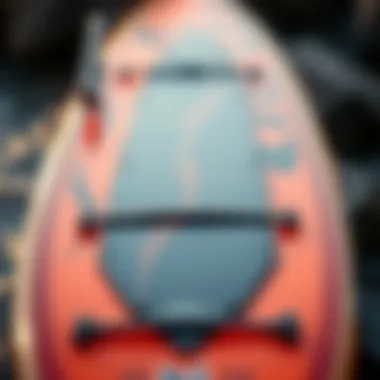
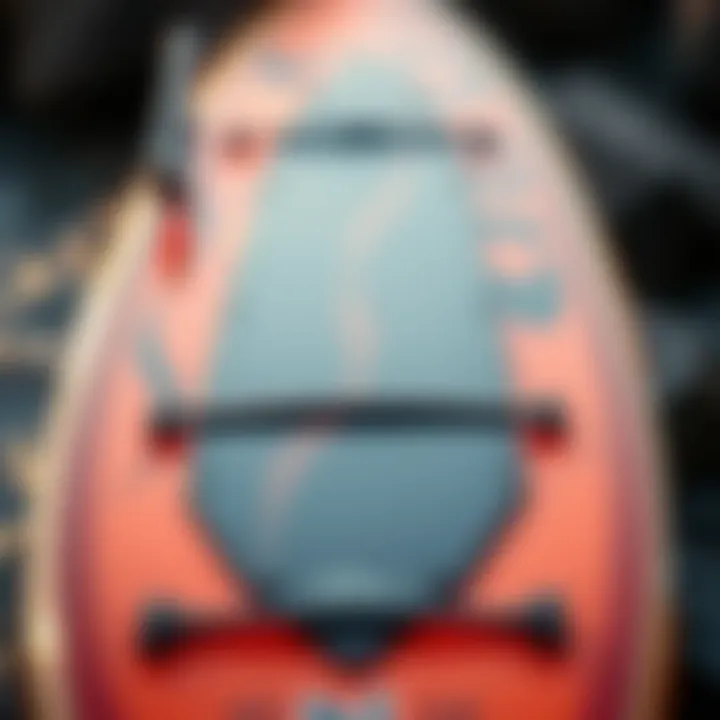
Foil dynamics explore how the foil interacts with the water and responds to different pressures, which is central to the effectiveness of wing surf foiling. The design of the foil itself – including its size, shape, and aspect ratio – drastically affects how it lifts the board above the water. A well-designed foil can make an average board come alive, allowing for smooth takeoffs and stable rides.
A critical aspect of foil dynamics is the balance between lift and drag. Riders need to understand how foil size impacts this relationship: larger foils produce more lift but can also create excess drag, slowing down the ride. Smaller foils provide less lift but ensure better maneuverability. Riders should think about their ride style when choosing:
- Larger foils: Great for light winds or heavier riders.
- Smaller foils: Suitable for high speeds and experienced riders.
Materials Used in Construction
A wing surf foil board is only as good as the materials used to construct it. Various materials offer a blend of durability, weight, and performance characteristics. Ideally, lightweight materials are favored without compromising strength. Most boards are made from materials like epoxy, carbon fiber, or foam composites.
- Epoxy: Known for its resilience and lightweight nature, epoxy boards are a popular choice among enthusiasts, balancing durability with performance.
- Carbon fiber: The go-to option for those prioritizing speed and responsiveness. It’s stiffer, which can lead to sharper handling but often comes at a higher price.
- Foam composites: These provide a great balance of performance and affordability, making them suitable for beginners and casual riders.
Choosing the right materials impacts everything from performance on the water to longevity of the board. Understanding these nuances of construction empowers riders to make informed choices that align with their style and needs.
"Investing in a quality board can make all the difference. Don’t just pick one off the rack. Research the materials that best fit your riding style."
Benefits of Wing Surf Foil Boards
The advantages of using wing surf foil boards are more than just a collection of perks; they fundamentally change the way enthusiasts experience water sports. Whether you’re gliding over flat waters or harnessing the winds in choppy conditions, this type of board introduces features that enhance your riding experience, making it a worthwhile investment for both novices and seasoned riders.
Enhanced Maneuverability
One of the standout benefits of wing surf foiling is its remarkable maneuverability. Unlike traditional boards that can feel bulky and cumbersome, wing surf foil boards are designed to be agile. Their unique shape and lighter materials allow for quick turns and shifts in direction. This agility is not just a luxury; it becomes essential when navigating crowded beaches or making quick decisions in unpredictable conditions.
Imagine trying to dodge an unexpected swell while still maintaining your speed. With a wing surf foil board, you can easily pivot, roll, and steer without the board feeling like an anchor dragging you down. This functionality is especially beneficial for riders who are looking to perform complex tricks or simply want to enjoy a more responsive ride.
"The ability to swiftly change direction can be the difference between a thrilling ride and a faceful of saltwater."
Reduced Drag and Increased Speed
The focus on reduced drag with wing surf foil boards is another game-changer. These boards are meticulously engineered to minimize resistance against water. The hydrofoil lifts the board above the surface, effectively reducing contact with the water and allowing for smoother, faster rides. This minimal drag factor becomes particularly noticeable during strong winds or fast-moving water, where traditional boards can struggle to maintain speed.
When you cut through the water with less effort, it becomes possible to achieve speeds that would leave a conventional setup in the dust. The enhanced speed not only adds to the excitement but also broadens the riding capabilities, letting you explore more challenging conditions. Many riders find that once they experience the improved speed and reduced drag, going back to traditional surfing feels like a significant downgrade.
Versatile Riding Conditions
The versatility of wing surf foil boards is perhaps one of their most appealing attributes. Designed to thrive in various conditions, these boards can easily adapt to light winds, moderate swells, and flat waters. Whether you wish to hit lakes, coastal waves, or open oceans, the adaptability of a wing surf foil board means you can pursue your passion wherever water is found.
Riders often report feeling more confident when switching locations. The ability to harness winds across different terrains adds a layer of enjoyment and discovery to the sport. Be it a morning session with gentle breezes or an afternoon chase through lively surf, the right foil board ensures that the fun never ceases, no matter the place or circumstances. This versatility appeals greatly to adventure seekers and casual riders alike, making the wingsurf experience all the more enjoyable.
In summary, the benefits of wing surf foil boards are significant. Enhanced maneuverability, reduced drag, and versatility in varying conditions not only elevate the riding experience but also make them a favorite among diverse water sports enthusiasts. As you explore the world of wing surfing, understanding these advantages will be crucial in maximizing your time on the water.
Choosing the Right Wing Surf Foil Board
Selecting the proper wing surf foil board is like picking the right pair of shoes before a grand adventure—there’s a specific fit for every individual, which can make or break the experience on the water. In this section, we will explore the critical factors that one should weigh up before making this investment, as choosing wisely can significantly enhance not only performance but also enjoyment out on the waves.
Factors to Consider
When looking for the right wing surf foil board, there are numerous aspects to think about. Consider the following:
- Skill Level: Your experience plays a huge role in choosing the right board. Beginners might find that a wider, more stable board keeps them balanced, while advanced surfers may lean towards something shorter and more maneuverable.
- Riding Style: Do you intend to cruise along the coast, or are you hoping to pull off fancy tricks? Your goal will greatly influence the type of board suitable for you. If trickery is your game, a lighter board may be your best bet for agile moves.
- Size and Volume: Board size isn’t just a matter of preference; it's about buoyancy and handling. A board with more volume will support your weight better, making it easier to lift off the water, while smaller boards can be more reactive and quicker to control.
- Foil Compatibility: Ensure your wing surf foil board matches up with your preferred foil type. Novices might start with a beginner-friendly setup while seasoned riders can experiment with more advanced foils.
- Material Quality: Examine the board’s materials. Epoxy and carbon boards tend to be lighter and more buoyant but also pricier, while foam boards offer a good value for anyone starting out.
- Local Conditions: Think about where you will be riding most often. Are you heading out in breezy, wavy conditions or are you more likely to be in calmer waters? The local environment can dictate the type of board that will work best in your favor.
Ultimately, a proper assessment of these elements will lead you to the board that complements your riding style and environment, letting you soar on the waves with confidence.
Common Brands and Models
When it comes to picking a wing surf foil board, familiarity with reputable brands and their standout models can simplify the decision-making process.
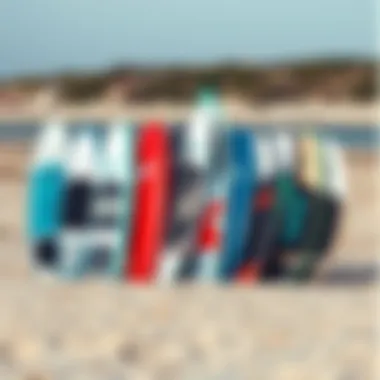
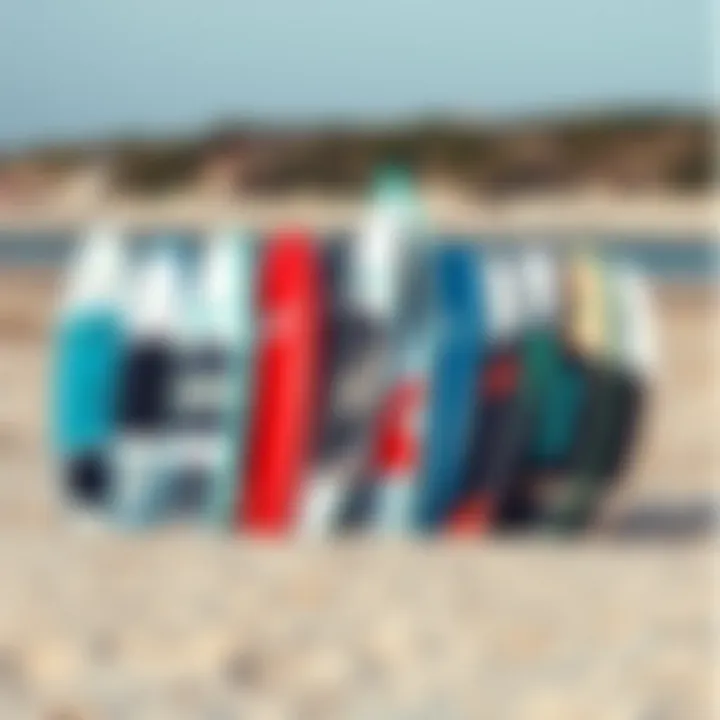
Some common brands in the wing surf foil world include:
- Slingshot: Renowned for their durability and performance, Slingshot boards fit a range of skill levels.
- Naish: A well-respected name in water sports, Naish’s boards are known for their versatility and stylish designs.
- Fanatic: They provide a selection of boards ideal for different styles, with a consistent focus on performance.
- Duotone: These boards carry a balance of lightweight properties and sturdy construction, perfect for both beginners and pros.
Popular models, such as the Slingshot Hover Glide or the Naish S26, often receive high praise for their balance of maneuverability and stability.
"Riding is not just about skill; it's about finding freedom on the water."
For more information about wing surf foam boards, visit Wikipedia or connect with enthusiasts on Reddit.
Mastering Wing Surf Foiling Techniques
Mastering wing surf foiling is not just about having the right equipment or skills; it’s a journey filled with learning, adjustment, and, importantly, practice. This technique is crucial for anyone who wants to fully enjoy the benefits of wing surf foiling. The beauty of riding on a hydrofoil, gliding above the water surface, is both exhilarating and liberating. However, getting the hang of it demands more than just jumping on a board and taking off. It requires a good understanding of the basic techniques, as well as more advanced maneuvers that can elevate your experience.
By honing your wing surf foiling skills, you’ll find yourself becoming more confident, agile, and in control when out on the water. This not only enhances your enjoyment but also ensures safety, especially in varying water conditions.
Basic Riding Techniques
When starting with wing surf foiling, it’s essential to develop a strong foundation in basic riding techniques. Here are some key elements to focus on:
- Stance: Your stance plays a critical role. Position your feet shoulder-width apart, with your knees slightly bent. This stance allows for better balance and control.
- Harness Usage: Learning how to correctly use a harness is important. This rigging helps you control the wing better, allowing your arms to remain relaxed while steering and holding the wing.
- Foot Placement: While riding, it’s imperative to adjust your foot placement based on conditions. The front foot should apply pressure for lift, while the back foot helps you steer your board efficiently.
- Balancing: If you feel yourself wobbling or losing balance, focus on looking at the horizon instead of down at the board; this helps maintain a steady composure.
- Takeoff and Landing: Practice proper takeoffs. Start by creating power with the wing while gradually putting pressure on your foils. As you get used to this, you'll master smooth landings by bringing the wing down evenly.
Advanced Maneuvers
Once you feel comfortable with the basics, moving on to advanced maneuvers can take your riding to new heights. Here are a few techniques to explore:
- Carving Turns: Carving involves shifting your weight to turn the board smoothly. Focus on using your hips to initiate turns while leaning in the desired direction. This technique enhances control and fluidity in your riding.
- Jumping: Taking your wing surf foiling off the water for a jump adds another layer of excitement. To achieve this, create a strong downward push with the back foot while pulling up on the wing, propelling you into the air. Timing is critical here - practice makes perfect.
- Downwinders: Mastering downwind techniques is essential, as they allow for advanced navigation while keeping speed. Starting from higher points and using the wind to glide can help you cover more distance elegantly.
- Transitions: Learning how to transition between different riding stances or even switching sides is key for any surfer. Smooth transitions keep your momentum and flow undisturbed.
- Wing-Only Riding: More advanced riders can experiment with wing-only riding to push their limits. This involves riding without the foil touching the water, focusing entirely on wing control.
"The performance of wing surf foiling is greatly influenced by the rider's mastery of techniques, whether simple or complex. "
Mastering these techniques enhances not just your skill level but also your overall riding experience. As with any sport, the learning never stops. Be patient with yourself, enjoy the process, and don't hesitate to seek advice from fellow riders or instructional videos. As you sharpen your skills, you will find greater joy sailing on the challenging waves and enticing winds of your choice.
Safety Practices for Wing Surf Foiling
Engaging in wing surf foiling can be an exhilarating experience, yet it carries risks that every participant must acknowledge. Understanding and implementing safety practices is not just a recommendation—it's a necessity. These practices help prevent accidents, boost confidence, and allow you to fully enjoy your time on the water. By equipping yourself with knowledge in safety protocols, you not only protect yourself but also contribute to the well-being of others around you. Here, we will break down essential safety practices into the two main categories: personal protective equipment and navigating water conditions.
Personal Protective Equipment
When it comes to wing surf foiling, personal protective equipment (PPE) can truly be the difference between a thrilling experience and a regrettable mishap. Investing in appropriate gear ensures your body is safeguarded against the unpredictable nature of the water and wind.
- Helmet: Wearing a helmet is crucial. It protects your head if you happen to fall or collide with your equipment or even other surfers. Seek helmets that are lightweight yet durable, designed specifically for water sports.
- Impact Vest: Consider using an impact vest that cushions your torso. These vests can mitigate injuries from falls, providing an extra layer of protection to your ribs and internal organs. They often come with buoyancy properties, aiding in flotation as well.
- Leash: A proper leash connects your wing to your board. This simple piece of equipment can prevent you from losing your board in the water, which, as you might imagine, can be a hassle—if not dangerous—if the board goes drifting away in strong wind or currents.
- Wetsuit or Drysuit: Depending on the climate, a wetsuit or drysuit may be needed to protect against the elements. These suits not only keep you warm but can also provide a barrier against abrasions when you tumble into the water.
- Foot Protection: Water shoes or boots can protect your feet from sharp objects that may lurk beneath the surface. Moreover, they offer traction, meaning less slippage on your board.
By donning the right protective gear, you set yourself up for a far safer and more enjoyable experience.
Navigating Water Conditions
Knowing how to read and navigate water conditions is equally vital for anyone keen on wing surf foiling. The ocean and lakes can be unpredictable, and having the know-how to adjust accordingly can keep you out of harm's way.
- Weather Forecast: Always check the weather before hitting the waves. Wind patterns can shift rapidly, and being surprised by sudden gusts or storms isn't just inconvenient; it can be perilous. Use apps or websites to monitor real-time conditions.
- Water Currents: Familiarize yourself with the currents in your chosen spots. Some areas have strong tidal movements or river flows that can carry you far from your intended path. Know your exit points or safe zones ahead of time.
- Swimmers and Marine Life: Stay alert for swimmers, surfers, or marine life in the vicinity. Collisions not only harm you but may endanger others. Watching your surroundings is essential.
- Launching and Landing Zones: Determine calm and safe areas for launching and landing your wing surf foil board. Check for obstacles in the water that could pose a threat during these critical moments.
"An ounce of prevention is worth a pound of cure."
For further information on kiteboarding safety, you may visit reliable sources such as Kiteboarding.com or the Safety and Fire Prevention from the National Safety Council.
Common Mistakes and How to Avoid Them
Wing surf foiling can be a thrilling experience on the water, yet there are several common pitfalls that riders often encounter. When doing something as dynamic as this, one misstep can lead to frustration or even accidents. Understanding these mistakes is crucial for both new enthusiasts and seasoned riders as it cultivates safety and enhances enjoyment. This section pinpoints the primary mistakes, offering strategies to bypass them and elevate your skills.
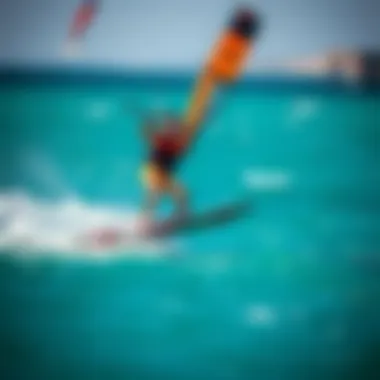
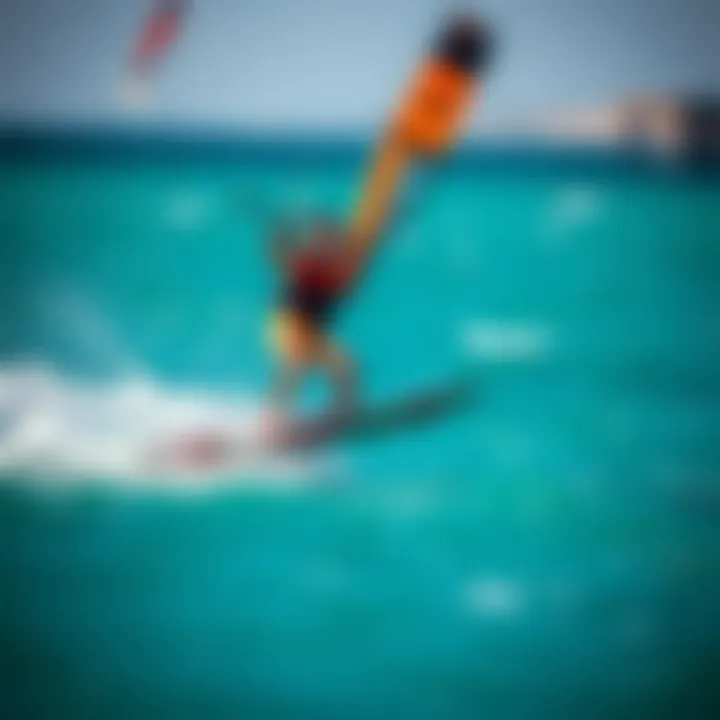
Improper Takeoffs
One of the most frequent blunders made by riders revolves around improper takeoffs. Solid takeoffs set the stage for a good ride. Many beginners think a powerful pull from the wing is enough; however, they often overlook the significance of timing and body positioning.
To achieve a successful takeoff, you must winter your sail correctly and position yourself properly relative to the water and wind. Here are some pointers:
- Check the wind direction: Before attempting to lift off, ensure you're facing the right way. The wind should draw across your wing from the side or a bit ahead.
- Knees bent, weight forward: Keep a low center of gravity by bending your knees. Leaning slightly forward can help maintain balance and speed through the takeoff.
- Engage core muscles: A stable core will keep your body steady as you transition from the water to the foiling position. This will give the board a good chance to lift without excessive wobbles.
"A good takeoff is not about muscle; it’s about timing and technique."
Practice makes perfect, so don’t be discouraged by initial struggles. Recognizing these crucial takeoff aspects can make all the difference.
Maintaining Balance
The art of maintaining balance while wing surfing cannot be understated. Many riders find themselves wobbling or even crashing due to the mismanagement of weight. While wings can propel you smoothly, they're also sensitive to shifts in your body weight and balance.
Here are a few techniques to ensure stability:
- Foot placement: Position your feet evenly over the board. Too far back can cause the nose to dive, while too far forward may lift you out of the water prematurely.
- Upper body alignment: Keep your upper body aligned with your lower body. Tensing up or leaning too much in one direction can lead to instability.
- Use your arms: Your arms hold the wing but also play a crucial role in balance. When facing unexpected movements, using your arms can help counteract shifts.
To become more attuned to your balance, consider practicing on flat water where conditions are lenient. As you progress, you can transition to more challenging environments where you can refine your skills.
By being aware of these common mistakes like improper takeoffs and maintaining your balance, you can better enjoy wing surf foiling. Learning from missteps is part of the journey, but with this knowledge, you’ll be better equipped to navigate the waters confidently.
Future Trends in Wing Surf Foiling
The world of wing surf foiling is constantly shifting, like the tide under a moonlit sky. As more enthusiasts embrace this exhilarating sport, understanding future trends becomes imperative for enthusiasts, manufacturers, and newcomers alike. The innovations on the horizon promise not only to enhance the experience but also to expand the community, creating a vibrant ecosystem of wing foilers.
Technological Advancements
Technology plays a pivotal role in shaping the future of wing surf foiling. The boards and foils of today might seem advanced, but the trajectory of innovation is poised to bring even greater enhancements. One notable trend is the development of lighter, more durable materials. For instance, the use of carbon fiber has gained traction, making boards more responsive and easier to maneuver.
Furthermore, advanced design features like adjustable foils and modular setups are emerging. These innovations allow riders to customize their equipment based on personal preferences and the conditions of the water. With the integration of digital technology, tracking systems may also become standard, giving riders access to real-time performance data and metrics.
It's essential to stay abreast of these developments. Riders who keep their ear to the ground can find the right equipment that matches their evolving skills and preferences.
Growing Popularity and Community Growth
The surge in popularity of wing surf foiling can be felt across coastlines and lakes worldwide. No longer confined to specialized groups, this sport has captured the imagination of outdoor enthusiasts everywhere. As more people take to the water, the community around wing foiling is expanding, forming clubs and online groups where tips, tricks, and stories can be shared.
Social media platforms are a driving force behind this trend. Riders post videos showcasing their feats, and platforms like Instagram and Youtube become treasure troves of tutorials and inspiration. This visibility encourages others to give wing surf foiling a try, leading to a positive feedback loop that grows the sport even more. Additionally, local events and competitions are becoming commonplace, providing a stage for riders to showcase their skills.
The sense of camaraderie among wing foilers is palpable. Participants bond over shared experiences, creating a welcoming environment for newcomers. This culture of support fuels further engagement, drawing in not just seasoned surfers but also adventurers looking for a new thrill.
"The thing that truly sets the wing surf foiling community apart is its openness. Everyone wants to help each other out, and that’s what makes it special."
As wing surf foiling continues to carve its niche, the future looks brighter than an unclouded sky.
The End
The conclusion of this guide serves an important purpose in synthesizing the wealth of information on wing surf foil boards. It's like tying together a bow on a well-crafted gift, ensuring that key insights and lessons gleam brightly for both novices and experienced riders alike. Here, the major takeaways about designs, benefits, techniques, and common pitfalls come to the forefront. Understanding these factors makes a significant difference in one's journey into wing surf foiling.
Summarizing Key Points
In review, the multifaceted world of wing surf foiling has been explored through several critical lenses:
- Design Elements: Good design is paramount, as it impacts not only performance but also enjoyment on the water.
- Benefits: From enhanced maneuverability to speed, the advantages of using these boards cannot be overstated; they open up new avenues for riders.
- Technique Mastery: Proper techniques, whether basic or advanced, are foundational to building confidence.
- Safety Practices: Wearing appropriate gear and understanding weather conditions is essential to minimizing risks.
- Future Trends: Keeping an ear to the ground on advancements in technology and community growth is vital to remain engaged in this field.
Encouragement to Explore Wing Surf Foiling
With all that's been discussed, there's a strong encouragement for anyone curious about this sport to dive in. Wing surf foiling offers not just an exhilarating ride but also a community of individuals who share the same passion for water sports. It fosters a sense of adventure and exploration, urging participants to push their limits while enjoying the backdrop of nature.
Whether it's the thrill of catching a wave or the serene feeling of gliding over calm waters, these experiences are waiting to be discovered. So grab a board, the right gear, and head out—it’s time to ride the winds with wings of your own!



